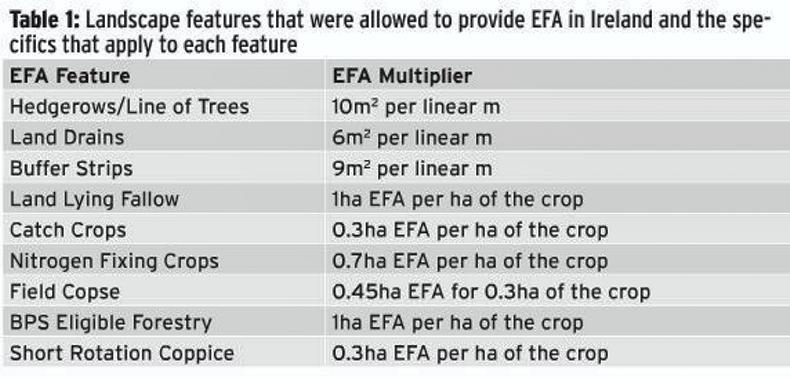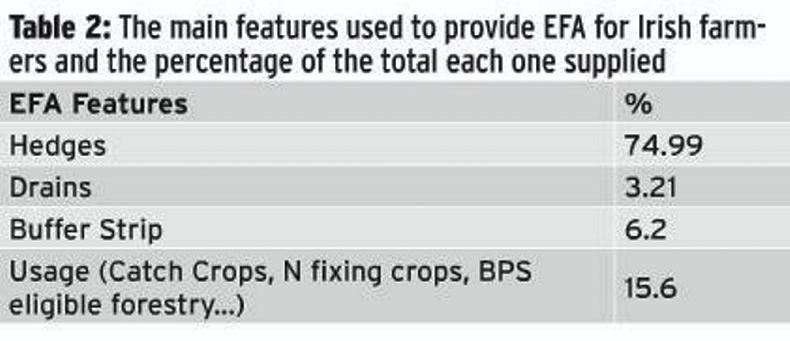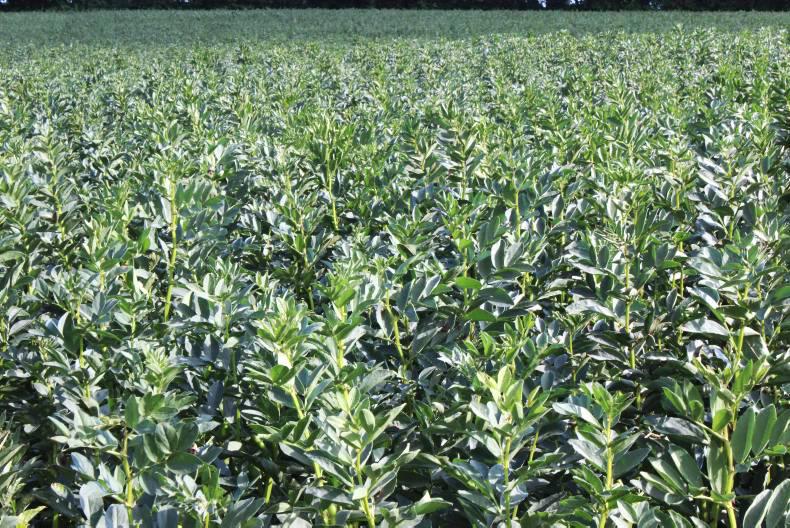While much of the current talk is about the skeleton on which a new CAP will be mounted, tillage farmers will need to be aware of changes that will apply for 2018 and beyond. These relate to new rules around greening which will come into force from 2018 and relate to specific changes to Ecological Focus Areas (EFAs).
The department indicates that, at present, approximately 5,400 farmers are obliged to abide by EFA obligations because they have more than 15ha of arable land. The greening rules oblige these farmers to have at least 5% EFA on their holding to be compliant. When the greening rules came into force in 2015 it was suggested that the 5% might increase to 7% within two years but this did not happen. For 2018 and future years, the obligation will continue to be 5% EFA.

When greening was first introduced, the Department decided to allow the features outlined in Table 1 to qualify as EFA, along with a multiplier which applied to each one.
The combination of these features enabled the vast majority of farmers to reach their 5% EFA requirement. Table 2 outlines the features which were mainly used on Irish farms to meet this 5% requirement and their contribution as a percentage of the total EFA recorded.

In 2017, the Department reported that the average EFA provided for in Ireland was 12.5%. For the vast majority of farmers, this was provided by features already on the farm, namely hedges, drains and buffer strips and hence most farmers did not have to modify their farming operation to provide enough EFA. Farmers who used area-based options, such as nitrogen fixing crops, had over 17% EFA.
Some growers who used an area-based option like a protein crop felt they had to do this because they were afraid that they might not make the 5% threshold with natural features alone. Anyone in this specific situation needs to pay particular attention to the changes that will be introduced for 2018.
1. Ban on the use of plant protection products on EFA
The revised regulation for 2018 has introduced a ban on the use of all herbicides, insecticides and pesticides on nitrogen fixing crops, catch crops and fallow used for EFA. Peas, beans and lupins are the qualifying nitrogen fixing crops which could be used as EFA in Ireland.
Because of the difficulties involved in managing such a ban for farmers, advisors and the Department, the use of nitrogen fixing crops will not be allowed as an EFA qualifying feature from 2018.
This change means that farmers who grow these crops in 2018 can continue to apply plant protection products in the normal manner, as the crop will not be bound by EFA constraints.
Fallow and catch crops will continue to be allowed as EFA but the ban on the application of pesticides, as set out in the original Guide to Greening, will continue within the defined periods.
2. Bigger multiplier for drains
Up to now, land drains qualified as 6m2 per linear metre for EFA purposes. From 2018 onwards this will increase to 10m2 per linear meter. This change will be automatically managed by the online application system in 2018 and will apply the increased value to the EFA calculation where drains are used for EFA.
3. Field margins to qualify as buffer strips
Currently, farmers are obliged to install and maintain buffer strips along the edge of watercourses for nitrates and cross compliance. These areas also qualify for use as EFA features, with 9m2 earned per linear meter (Table 1 above). From 2018 field margins, other than those by watercourses, can also qualify as EFA.
These margins also require a 2m uncultivated strip plus the basic maintenance measures required for buffer strips. However, as with the watercourse buffers, they may be easier to maintain where problems like brome etc exist if they are actually 3m-4m wide. These can be added to 2018 BPS applications by farmers/advisors via the iNet online systems.
4. Field copse
For growers who have field copse on their farms, the maximum area that could previously apply to EFA was 0.3ha. This maximum area has been removed so features greater than 0.3ha can now qualify. However, the maximum area that can be used for EFA is still effectively restricted to 0.3ha as copse has been given a 1.5 multiplier and the maximum EFA contribution is capped at 0.45 ha ie 0.3x1.5=0.45.
Protein aid scheme 2018
The Protein Aid Scheme effectively ended in 2017 and the presence of a scheme for 2018 and beyond has not yet been confirmed. However, the Department have confirmed that a 2018 scheme is currently being considered under the terms and conditions for the Direct Payment Schemes for 2018 and so it is at least possible that the scheme will apply again in 2018.
An additional plus for EFA margins
The contribution of conservation bio-control in controlling pests has been valued at close to 10 times greater than that of chemical control.
With this in mind, one needs to understand how to fully promote and use this naturally occurring free resource in crop protection. This was evident from a number of the papers and questions posed at the recent ITLUS conference.
The prospect of field margin strips or buffer zones (not just beside water courses) being allowed as EFA area for 2018 and beyond pose additional questions with regard to their potential as habitats for natural predators of crop pests, especially for aphids.
There is now a real need to better understand the potential benefits and risks which producers face when using such measures.
There was a feeling that field margin strips sown to grass could help harbour aphid predators which could help decrease the pressure and incidence of BYDV in fields.
If EFA strips could do this, they would have an added advantage, but it is essential that research validate their usefulness in this regard.
Such measures may well be the future of biological control systems, which must be more than the use of just a single agent. However, there is always the risk that these margins could also shelter the very pests they are expected to help control and so evaluation is essential.
While much of the current talk is about the skeleton on which a new CAP will be mounted, tillage farmers will need to be aware of changes that will apply for 2018 and beyond. These relate to new rules around greening which will come into force from 2018 and relate to specific changes to Ecological Focus Areas (EFAs).
The department indicates that, at present, approximately 5,400 farmers are obliged to abide by EFA obligations because they have more than 15ha of arable land. The greening rules oblige these farmers to have at least 5% EFA on their holding to be compliant. When the greening rules came into force in 2015 it was suggested that the 5% might increase to 7% within two years but this did not happen. For 2018 and future years, the obligation will continue to be 5% EFA.

When greening was first introduced, the Department decided to allow the features outlined in Table 1 to qualify as EFA, along with a multiplier which applied to each one.
The combination of these features enabled the vast majority of farmers to reach their 5% EFA requirement. Table 2 outlines the features which were mainly used on Irish farms to meet this 5% requirement and their contribution as a percentage of the total EFA recorded.

In 2017, the Department reported that the average EFA provided for in Ireland was 12.5%. For the vast majority of farmers, this was provided by features already on the farm, namely hedges, drains and buffer strips and hence most farmers did not have to modify their farming operation to provide enough EFA. Farmers who used area-based options, such as nitrogen fixing crops, had over 17% EFA.
Some growers who used an area-based option like a protein crop felt they had to do this because they were afraid that they might not make the 5% threshold with natural features alone. Anyone in this specific situation needs to pay particular attention to the changes that will be introduced for 2018.
1. Ban on the use of plant protection products on EFA
The revised regulation for 2018 has introduced a ban on the use of all herbicides, insecticides and pesticides on nitrogen fixing crops, catch crops and fallow used for EFA. Peas, beans and lupins are the qualifying nitrogen fixing crops which could be used as EFA in Ireland.
Because of the difficulties involved in managing such a ban for farmers, advisors and the Department, the use of nitrogen fixing crops will not be allowed as an EFA qualifying feature from 2018.
This change means that farmers who grow these crops in 2018 can continue to apply plant protection products in the normal manner, as the crop will not be bound by EFA constraints.
Fallow and catch crops will continue to be allowed as EFA but the ban on the application of pesticides, as set out in the original Guide to Greening, will continue within the defined periods.
2. Bigger multiplier for drains
Up to now, land drains qualified as 6m2 per linear metre for EFA purposes. From 2018 onwards this will increase to 10m2 per linear meter. This change will be automatically managed by the online application system in 2018 and will apply the increased value to the EFA calculation where drains are used for EFA.
3. Field margins to qualify as buffer strips
Currently, farmers are obliged to install and maintain buffer strips along the edge of watercourses for nitrates and cross compliance. These areas also qualify for use as EFA features, with 9m2 earned per linear meter (Table 1 above). From 2018 field margins, other than those by watercourses, can also qualify as EFA.
These margins also require a 2m uncultivated strip plus the basic maintenance measures required for buffer strips. However, as with the watercourse buffers, they may be easier to maintain where problems like brome etc exist if they are actually 3m-4m wide. These can be added to 2018 BPS applications by farmers/advisors via the iNet online systems.
4. Field copse
For growers who have field copse on their farms, the maximum area that could previously apply to EFA was 0.3ha. This maximum area has been removed so features greater than 0.3ha can now qualify. However, the maximum area that can be used for EFA is still effectively restricted to 0.3ha as copse has been given a 1.5 multiplier and the maximum EFA contribution is capped at 0.45 ha ie 0.3x1.5=0.45.
Protein aid scheme 2018
The Protein Aid Scheme effectively ended in 2017 and the presence of a scheme for 2018 and beyond has not yet been confirmed. However, the Department have confirmed that a 2018 scheme is currently being considered under the terms and conditions for the Direct Payment Schemes for 2018 and so it is at least possible that the scheme will apply again in 2018.
An additional plus for EFA margins
The contribution of conservation bio-control in controlling pests has been valued at close to 10 times greater than that of chemical control.
With this in mind, one needs to understand how to fully promote and use this naturally occurring free resource in crop protection. This was evident from a number of the papers and questions posed at the recent ITLUS conference.
The prospect of field margin strips or buffer zones (not just beside water courses) being allowed as EFA area for 2018 and beyond pose additional questions with regard to their potential as habitats for natural predators of crop pests, especially for aphids.
There is now a real need to better understand the potential benefits and risks which producers face when using such measures.
There was a feeling that field margin strips sown to grass could help harbour aphid predators which could help decrease the pressure and incidence of BYDV in fields.
If EFA strips could do this, they would have an added advantage, but it is essential that research validate their usefulness in this regard.
Such measures may well be the future of biological control systems, which must be more than the use of just a single agent. However, there is always the risk that these margins could also shelter the very pests they are expected to help control and so evaluation is essential.








 This is a subscriber-only article
This is a subscriber-only article





SHARING OPTIONS: